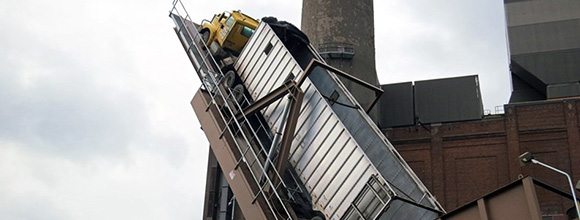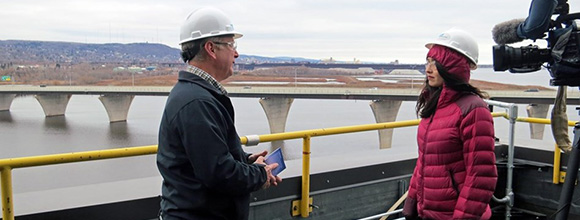Storm's 'silver lining' puts Hibbard in the spotlight
Dec 2, 2016
The last of the wood debris from the July 21 storm in the Duluth area was burned at Hibbard Renewable Energy Center in West Duluth in late November and early December and generated electricity for Minnesota Power customers.
Dave Rannetsberger, manager of renewable business operations for Minnesota Power, said about 25 truckloads, or more than 500 tons of wood debris per day, fueled Hibbard’s generators, double the usual daily influx of biomass to make steam for the adjacent Verso paper mill.
Hibbard sent about 20 megawatts of electricity, enough to power about 20,000 homes, to Minnesota Power’s customers while the wood lasted.
In one week, the trucks hauled an estimated 4,000 tons of wood debris to Hibbard until all of it was removed from the city of Duluth’s Morningside gravel pit off Jean Duluth Road. Since the storm in July, Hibbard has burned about 9,000 tons of storm debris, or more than 425 truckloads. The renewable energy center also used wood debris from the storm to generate electricity in August.
"It really puts a silver lining" on the storm, Frank Frederickson, general manager of renewable operations, told reporters invited to Hibbard on Dec. 2 to document the beneficial local use of the storm debris.
Rannetsberger explained the role biomass generation at Hibbard plays in Minnesota Power’s energy mix. While Hibbard produces steam 24 hours a day for the nearby Verso paper mill, it is a "dispatch" generator of electricity, meaning it can send power to the grid whenever needed. That role balances the intermittent generation by other renewable sources such as wind and solar power.
"Other sources of renewable energy can be stored in various ways such as batteries," he said. "In this case, Mother Nature stores the renewable energy in the trees, so we can use it when it’s needed most."
He also stressed the economic importance of Hibbard, which supports more than 300 jobs at the Verso mill and the renewable energy center, along with many other jobs for local loggers and truckers.
Frederickson said renewable biomass generation is a good fit for northern Minnesota because of the abundance of forest products and producers. The plant uses limbs, tree tops and other wood that is chipped and ground, and most of it comes from within 100 miles of Duluth.
"We use what used to be considered waste," he said.
The storm that hit the area this summer left behind downed trees and limbs from Duluth to Island Lake.
Seeing the potential to put that wood to use, Minnesota Power’s storm response team and the city of Duluth reached a deal for the wood collected in Duluth to be chipped and shipped to Hibbard for use as cost-effective renewable fuel. Some chipped wood from the Island Lake area has gone to Hibbard, too.
With the city of Duluth’s storm-damaged biomass used up, there still will be storm wood debris from St. Louis County and Rice Lake, said Matt Radzak, renewable fuels coordinator. Along with other storm-damaged wood from private and public timber sales, he estimates Hibbard has another 6-12 month supply of low-cost, storm-damaged biomass yet to burn.





